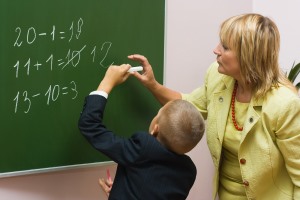How Can I Support a Student With Dyscalculia?
Posted by PLB Blogger · Leave a Comment

 Dyscalculia is a form of learning disability whereby the student has difficulty with math. Dyscalculia may impact the person’s ability to tell time, manage money or shop independently. Dyscalculia can be caused due to deficits in the:
Dyscalculia is a form of learning disability whereby the student has difficulty with math. Dyscalculia may impact the person’s ability to tell time, manage money or shop independently. Dyscalculia can be caused due to deficits in the:
Visual spatial abilities with features like:
- Reversal of numbers (writing 6 instead of 9, 3 backwards)
- Difficulty copying numbers from the board or on dictation
- Incorrect placement of numbers (32 instead of 23)
- Difficulty in writing the numbers in line, losing place in long division etc
- Placing the decimal points incorrectly
Information and language processing skills causing:
- Difficulty understanding mathematical concepts including fractions, speed, time etc
- Inability to solve problems requiring multiple tasks e.g. addition, multiplication etc
- Failure to understand and remember sequences
- Inability to identify crucial information required to solve complex equations
- Inability solving word problems
- Inability to organize, self check and explore alternatives for solution solving
The first step to helping a student with dyscalculia is to identify the student’s areas of strength and weakness. Once we identify these, we can use the strategies outlined to support students.
Explain Terminology: Terms such as diameter, radius, inverse proportions and fractions can certainly be overwhelming for a student with dyscalculia. Multisensory learning through stories, craft, visual presentations, activities and games may be used to explain different terminology. Students need to understand these before they can start solving problems.
Simplify the steps: A Student with a deficit in sequencing and memory may benefit from written instructions or pictorial representations to solve an equation. In addition, it will be easier for the child to understand if the instructions are broken down into steps and simplified. Use of mnemonics, chunking and other memory strategies has also proven useful to remember the order for solving various equations. Instead of asking the student to copy from board, give them pre written worksheets to avoid errors. While attempting word problems, highlight the crucial terms (how much more did “A” get) to assist the student in understanding and solving the question. You can also reduce the number of questions on one paper and teach the students to draw a line after each question to signal the end of that question.
Modify the tools: Incorporate the use of graph paper, ruled books, rulers etc to help students with visual spatial difficulties. Encourage students to use colored pens when they have to overwrite or carry forward a number. Students may be asked to to divide the page so that there is a specific column for rough work, to number their rough work or use different colors to avoid confusions. Color coding is also helpful while teaching to add or subtract starting with the ones followed by tens and hundreds.
Explore avenues of learning: Using whole body learning i.e. tracing the numbers using entire arm through air, learning to add and subtract by going up and down stairs, learning through tactile-kinesthetic input help students learn with all their senses, and this can help compensate for visual-spatial difficulties.
Using assistive devices: Calculators and abacus are the most commonly used assistive devices to help students with dyscalculia. As technology progresses there are various newer models of devices that are available on the market and these are chosen bearing in mind the purpose, need, requirements of the student and in discussion with the parents and a professional. These are several other aids that can help students learn math including pattern blocks, geoboards and base ten blocks.
Discuss here: What tools do you use in the classroom to make math easier to understand?
Learn more: Take a course



